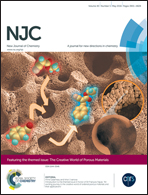Application of a novel electrochemical sensor based on modified siliceous mesocellular foam for electrochemical detection of ultra-trace amounts of mercury ions†
Abstract
This paper describes a facile and direct electrochemical method for the determination of ultra-trace Hg2+ by employing dithizone-functionalized siliceous mesocellular foam as an enhanced sensing platform. The synthesized mesoporous electrode material was characterized using Fourier transform infrared spectrometry, scanning electron microscopy, elemental analysis, a nitrogen adsorption–desorption study and thermal analysis. A carbon paste electrode was modified with the dithizone-functionalized siliceous mesocellular foam, and differential pulse anodic stripping voltammetry (DPASV) was applied as the detection technique after open-circuit sorption of Hg2+ ions. Mercury ions were preconcentrated on the surface of the modified electrode by complexing with dithizone and reduced at a negative potential (−0.9 V). Then the reduced products were oxidized by the DPASV procedure. The modified electrode response to Hg2+ was linear in the 0.01 nmol L−1 to 0.5 nmol L−1 (with sensitivity of 7.53 μA (nmol L−1)) and in the 0.5 nmol L−1 to 10.0 nmol L−1 (with sensitivity of 3.01 μA (nmol L−1)) concentration ranges. The method detection limit (MDL) of the sensor was 3.0 pmol L−1 (at S/N = 3). The sensor was successfully applied to the trace determination of Hg2+ in spiked environmental water samples.


 Please wait while we load your content...
Please wait while we load your content...